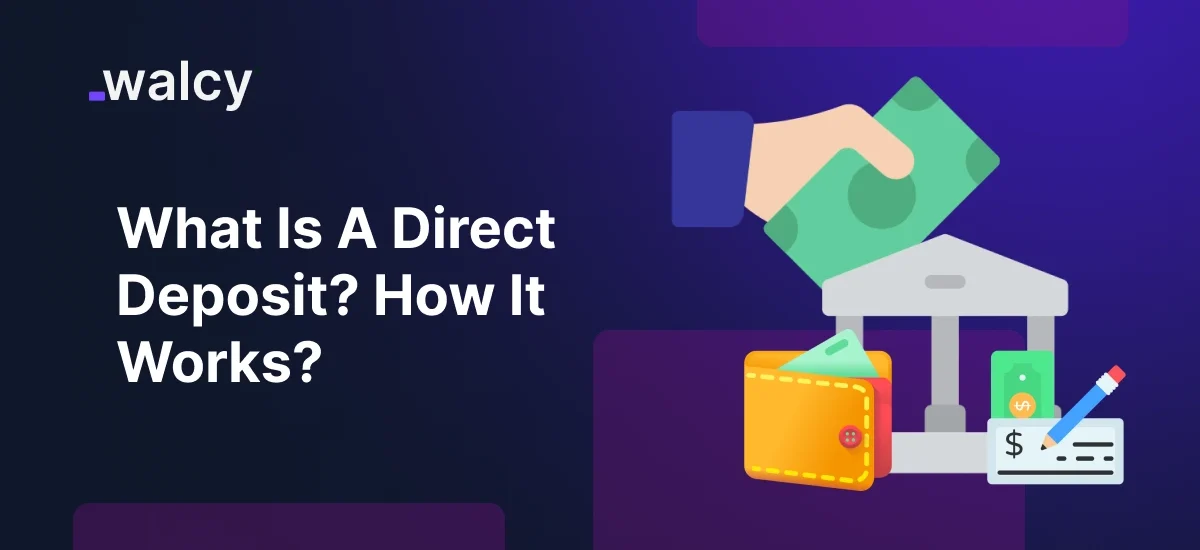Nowadays, money transactions are much faster in the modern age with payments being more secure, faster, and convenient.
Direct deposit is one of the most widespread types of electronic payments. It has revolutionized how businesses and individuals pay and receive between businesses and individuals by eliminating paper checks and reducing processing time.
One electronic payment option is direct deposit, in which money is sent straight into the payee’s bank account.
Starting from a paycheck, tax refund, or government aid, direct deposit ensures the safe and convenient transfer of money without checks.
Direct deposit in this text will be talked about on the mechanism of working, benefits, differences from wire transfers, as well as various examples of direct deposit in different industries.
What is a Direct Deposit?
Direct deposit is an EFT that transfers money from one bank account to another.
It is utilized by employers, the government, and businesses to disburse payments of wages, tax refunds, and benefit payments without the need for paper checks.
Rather than the delivery of a paper check that would be manually processed, direct deposit facilitates hassle-free and automated transfers, with recipients being able to access funds immediately.
It is used extensively across the globe because it is efficient, secure, and reliable.
How Direct Deposit Works?
The direct deposit process is easy but very secure:
Authorization: The recipient provides the payer (government agency, business, or employer) with their bank account details (routing number and account number).
Initiation of Payment: The payer initiates the payment through an electronic means, which is usually the Automated Clearing House (ACH) network.
Bank Processing: The payment is directed to the recipient bank, where it is processed and verified.
Confirmation of Deposit: Funds are electronically deposited to the recipient, and they can withdraw or spend them right away.
The process is entirely automated and typically done in 1-2 business days, far faster and more secure than paper check payment.
Benefits of Using Direct Deposit
Direct deposit enjoys several advantages over paper checks and other forms of payment:
Convenience: Automatically deposit money without having to visit the bank or cash a Cheque.
Speed: Quicker processing than checks, so funds can be received immediately.
Security: Reduces loss, theft, or forgery of checks.
Cost-Effective: It saves dollars for individuals and businesses by eliminating the cost of manual printing and postage on checks.
Green: Reducing paper usage associated with hard-copy checks.
Reliability: Guarantees that payments are made timely without delay due to mail delivery or check clearing times.
Direct Deposit vs. Wire Transfer
While wire transfers and direct deposits both facilitate electronic transfer of funds, they differ in key ways:
Direct deposits take effect in 1-2 business days, while wire transfers can take a few hours or even the same business day. Fee is the second main difference; direct deposits are free or slightly charge fees,
While
Wire transfers charge more expensive transaction fees, especially for overseas transfers.
Direct deposit is generally used for regular transactions such as payroll, tax refunds, and government payments. Wire transfer is generally used for irregular, large-value payments, most especially foreign remittances.
Security is sound on both methods, although wire transfers are more vulnerable to fraud since they are non-revocable. Although direct deposit transactions may be reversible in the event of an error, wire transfers are typically final when executed.
Usually, direct deposit is the most suitable option for routine payments, whereas wire transfers are ideal for high-priority, high-value transfers that need to be conducted at a faster rate.
Read about: Charges For Wire Transfer From India To Canada.
Direct Deposit Example
To discover more on the usage of direct deposit, observe the examples below:
Employer Payroll: The employer renders the salary of workers payable electronically to the workers’ accounts on payment day.
Government Benefits: Pension, unemployment compensation, and Social Security payments are sent directly to people using direct deposit.
Tax Refunds: Taxpayers are directly credited their refunds by the Internal Revenue Service in their bank accounts instead of the issue of checks.
Vendor Payments: Companies utilize it to make efficient payments to suppliers and service providers directly.
Student Financial Aid: Colleges provide a direct deposit of scholarships and financial aid into students’ bank accounts.
Setting up Direct Deposit
setting up it is a simple process, but always make sure to be precise to enable easy transactions. Follow these step-by-step procedures and complete the setup with ease:
-
Get a Direct Deposit Authorization Form
Your employer, payer, or government agency will give you this form.
In other organizations, you can complete the process online through a secure portal.
-
Provide Correct Banking Information
Type in the right bank name, account number, and routing number.
Retype the information twice to prevent any errors that would delay payments.
If you have more than one account, ensure that you type in the correct one to receive deposits.
-
Select Deposit Options (if permitted)
Some employers allow you to divide your deposit into multiple accounts (e.g., checking and savings).
Indicate the amount of dollars or percentage to be deposited into a given account.
-
Form Submission
Mail the filled-out form to your employer, payroll office, or payer.
Fill up the instructions given if using an online setup, and submit as such.
-
Undergo a Verification Process
Certain employers initiate a test deposit (also known as a micro-deposit) by making a small payment (e.g., a few cents) to verify account accuracy.
You may be required to verify your account and agree to the test deposit amount before direct deposit can be activated.
-
Receive Deposits
After approval, payments are deposited directly into your account on the specified dates.
Check bank statements to verify the deposits have been made in a timely fashion.
How Secure is Direct Deposit?
Direct deposit is among the secure methods of payment as it is automated and encrypted. Banks and other financial firms use advanced security measures to protect sensitive information.
However, customers need to be cautious and not give bank information to unauthorized individuals to keep it from fraud or identity theft.
Read about: Encryption Vs Tokenization: Which Is Better?
Challenges with Direct Deposit
Despite multiple benefits, direct deposit also has a few challenges:
Bank Account Requirement: There is a bank account requirement for direct deposit, and as such, it cannot be utilized by people who only deal in cash transactions or are not part of the banking system.
Processing Delays: These are quick, but some take a business day to a business day to be processed, depending on the bank system and the timing of when the deposit request is initiated.
Risk of Fraud: Although it is secure, the online risks of phishing and identity theft cannot be avoided. Bank details can be requested by hackers through spurious emails or messages.
Limited Application for Specific Transactions: It is less effective for cash payments or transactions with rapid physical exchange of currency, limiting its application in certain business sectors or single transactions.
Employer or Institution Dependence: Employees and recipients rely on their employer, government, or financial institution to initiate and correctly process direct deposits, sometimes causing administrative mistakes or delayed payments.
Technical Glitches: Shutdowns of banking systems, maintenance hours, or computer software malfunctioning may cause delays in deposit processing, thus the necessity for users to have an alternative financial plan.
Hindrances to Altering Banking Details: Receiving direct deposit involves coordination with employers or institutions, and bank detail errors can lead to the denial of transactions or sending funds in the wrong direction.
Future of Direct Deposit
With FinTech and online banking on the move, direct deposit is also on the move. Some of the most significant trends include:
Real-time Payment Systems
New technology is reducing processing times so that real-time payments may be made.
Direct deposit is 1-2 business days, but modern real-time payment (RTP) technology enables Instant access to funds.
Beneficial for freelancers and gig workers who prefer easy access to funds.
Blockchain Integration
Blockchain and decentralized finance (DeFi) offer improved security and efficiency for transactions.
Smart contracts make payroll processing automated, cutting out middlemen and reducing errors.
Improves fraud prevention through increased payment traceability.
Mobile Banking Growth
Mobile applications are becoming increasingly popular among customers for managing deposits and tracking transactions.
Real-time tracking, real-time alerts, and automatic savings capabilities improve money management.
No doubt, consumers can split deposits into several accounts and pay bills automatically.
Adoption Globally
Direct deposits are increasing globally with advanced digital banking platforms.
Many countries are adopting automated clearing house (ACH) technology to make cross-border transactions seamless.
Serves international employees, expats, and global businesses with international payroll needs.
Along with these advances, it becomes simpler, more secure, and faster, making it an electronic payment choice in the years to come.
Read about: The Evolution of Banking in India: From Tradition to Digital
Conclusion
Direct deposit is a, fast, secure payment system typical of payroll, tax refunds, and other payment terms. The value added by it over the traditional check is favored by employers, employees, and banks.
People and institutions know that they can pay more effectively through the understanding of how it operates, its advantages, and where it is today concerning the financial changes continuously occurring.
As electronic banking develops, it will form the basis for modern financial transactions, leading the way to a more secure and simpler payment environment.
Do follow us on Facebook and LinkedIn, to stay connected with us.



